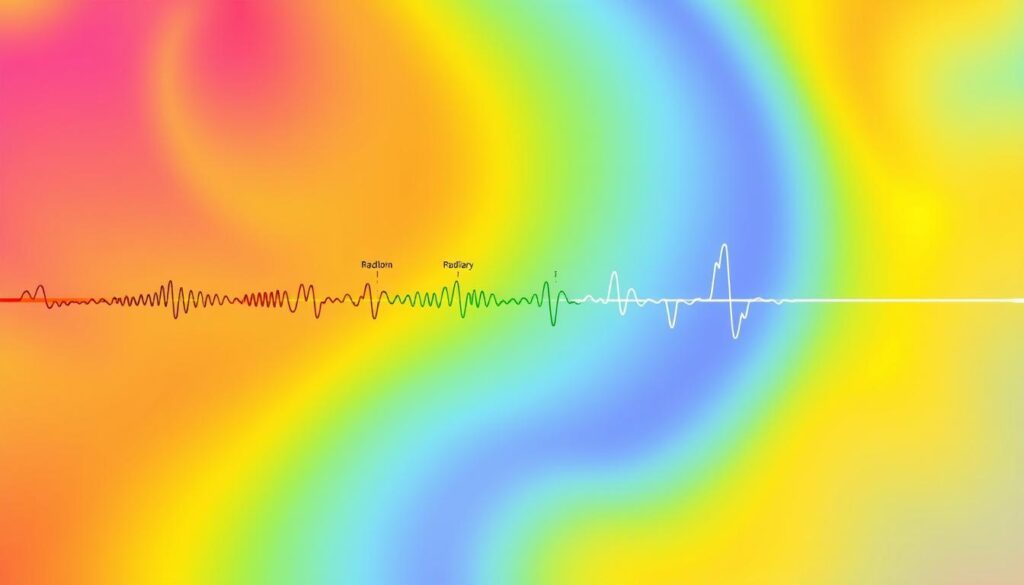Waves are key to understanding energy. They include light, sound, and ocean waves. The link between wavelength and frequency helps us grasp their nature and how they work.
Waves move in a pattern and carry energy without moving particles. They come in two types: transverse waves like light and water, and longitudinal waves like sound and pressure. Knowing how wavelength and frequency are connected is vital for understanding waves.
Wavelength is the distance between two points on a wave. Frequency is how many times a wave goes up and down in a second. The frequency equation shows how they’re connected: V = λf. Here, V is the speed of the wave, λ is the wavelength, and f is the frequency.
Key Takeaways
- Waves are characterized by repetitive motion and energy transfer without net particle movement.
- Wavelength (λ) is the distance between two consecutive identical points on a waveform, while frequency (f) is the number of oscillations per unit time.
- The relationship between wavelength and frequency is expressed by the equation: V = λf, where V represents the wave speed.
- Understanding the inverse relationship between wavelength and frequency is crucial for comprehending the behavior and properties of light, sound, and other forms of electromagnetic radiation.
- Manipulating waves based on frequency, wavelength, and speed is essential for various applications, such as communication and medical imaging.
Understanding Wave Properties and Wave Motion
Waves are all around us, from the calm ripples on a pond to the bright light waves that light up our world. They help us understand how energy moves. Let’s explore the amazing world of waves and learn about their parts, types, and how they move and share energy.
Basic Wave Components
Every wave has key parts like crests, troughs, amplitude, and wavelength. These parts make up a wave cycle. Knowing these basics helps us understand wave properties, inverse relationship, and light waves.
Types of Waves in Nature
The world is full of different waves, like sound and water waves, and light and radio waves. Each wave has its own special traits and follows its own rules. Learning about these wave properties is a fun way to see how our world is connected.
Wave Motion and Energy Transfer
Wave motion is all about moving energy without moving matter. As waves go through a medium, they make the particles move back and forth. This lets the energy move without the medium itself moving. The speed of a wave depends on the medium it goes through, and energy is shared through the moving particles in the wave properties.
“Waves are the language of the universe, carrying information and energy across the cosmos. Understanding their intricate dance is the key to unlocking the secrets of the natural world.”
| Wave Type | Wavelength Range | Example |
|---|---|---|
| Sound Waves | 70 mm to 70 m | Human hearing range |
| Water Waves | 30 – 50 m (Surf Waves) 100 km (Tsunamis) |
Ocean waves and tides |
| Electromagnetic Waves | 10 m (Radio Waves) Hundreds of nanometers (Visible Light) |
Radio, TV, Microwaves, Infrared, Visible Light, Ultraviolet, X-rays, Gamma Rays |
Relationship of Wavelength and Frequency
In the world of waves, wavelength and frequency are closely linked. They show an inverse relationship. When wavelength goes up, frequency goes down, and vice versa.
The Inverse Relationship Formula
The frequency equation shows this link: V = λf. Here, V is wave speed, λ is wavelength, and f is frequency. This formula shows how these wave traits are connected.
Wave Speed and its Dependencies
Wave speed, or V, is key in this equation. It changes based on the medium it travels through. For instance, light in a vacuum moves at 3.00 × 10^8 m/s, known as the speed of light (c).
Mathematical Expression: V = λf
By changing the frequency equation, we can find wavelength or frequency. This lets us dive deeper into the inverse relationship. It’s vital for understanding wave phenomena, like energy quantization in the electromagnetic spectrum.
The link between wavelength and frequency is key in wave theory. It affects many areas, from physics to communications and more.
Exploring Frequency: The Wave’s Time Component
Frequency is key in wave phenomena. It shows how waves change over time. It’s measured in Hertz (Hz), which is how many cycles a wave has in one second. Humans can hear waves from 20 Hz to 20,000 Hz.
Higher frequencies mean more energy. This is shown in the equation E = hf. Here, E is energy, f is frequency, and h is Planck’s constant. This idea is central to quantum mechanics.
Frequency is the opposite of period. Period is how long it takes for a wave to go through one cycle. The formula is frequency = 1 / period. This helps us switch between frequency and period easily.
Wave speed is different from frequency. It’s how fast a wave moves. The formula is v = λf. Here, v is speed, λ is wavelength, and f is frequency.
Knowing about frequency, period, and their connection is important. It helps us understand the electromagnetic spectrum, photon energy, and wave-particle duality. By learning about these, we can see the physics of our world better.

“Frequency is the number of complete vibrations or cycles that occur in a given amount of time, usually one second.”
Wavelength: Understanding Spatial Wave Characteristics
Wavelength is key to waves, showing how they act and look. It’s measured in meters or nanometers for tiny things. The color of light and sound pitch depend on wavelength. Visible light’s colors range from 380 to 740 nm.
The wavelength is how far a wave’s shape goes before it repeats. It’s the opposite of frequency – the higher the frequency, the shorter the wavelength. This is shown as v = λf, where v is speed, λ is wavelength, and f is frequency.
Wavelength is important in many wave actions, like dispersion and interference. In dispersion, light colors spread out because different wavelengths move at different speeds. This is why we see rainbows. Wavelength also shapes the patterns we see when waves pass by objects, a key idea in light waves and energy quantization.
| Wavelength Examples | Frequency Range | Applications |
|---|---|---|
| Sound waves in air | 20 Hz – 20 kHz | Audible to the human ear, with wavelengths ranging from 17 m to 17 mm |
| Visible light | 400 nm – 700 nm | The visible light spectrum, from deep red to violet |
| Radio waves | 3 kHz – 300 GHz | Used for communication, broadcasting, and radar systems |
Knowing about wavelength is vital in many fields. It helps in optics, acoustics, and more. It’s key for new tech and how we use waves.

Conclusion
The link between wavelength and frequency is key to knowing how waves work. This link is shown in the equation V = λf. It’s true for all kinds of waves, like sound and light.
Knowing this link is very important. It helps us understand things like the Doppler effect and how light works. It also helps us know about the electromagnetic spectrum.
Understanding wavelength and frequency helps us see how waves move. This knowledge is useful for many things, like radio and light. It lets us explore the world of waves in a deeper way.
As you learn more about physics, knowing about wavelength and frequency is very helpful. It’s a basic idea that helps you understand many wave-related topics. It lets you analyze and use waves in new and exciting ways.


A Life-Changing Experience with This Weight Loss Supplement (Nagano Tonic)
I’ve always struggled with finding a weight loss solution that actually works for me. Like many, I’ve tried numerous diets, exercise routines, and supplements over the years—some worked for a short time, but nothing ever gave me long-term results. That was until I decided to try the weight loss supplement I found : Link to the Supplement.
From the moment I started using it, I noticed a difference. Not only did I feel more energized, but my cravings also became more manageable. The best part? I started seeing results much quicker than I anticipated! Over the course of just a few weeks, I noticed a significant reduction in belly fat and overall weight loss that I hadn’t been able to achieve before.
What makes this supplement stand out from all the others I’ve tried is how it supports me in my daily routine without any jitters or energy crashes. I’m able to stay focused and motivated, which has made it easier to stay on track with my diet and exercise plan.
This product truly exceeded my expectations, and I feel more confident and healthier than ever before. If you’re struggling with your weight loss journey like I was, I highly recommend giving this supplement a try. It’s been a game-changer for me, and I’m sure it can work wonders for you too!
Contant Them on email .. tonicnagano50@gmail.com
I’ve tried so many weight loss products over the years, but nothing worked like this supplement! Since I started using it, I’ve noticed a big difference in my energy levels and appetite control. In just a few weeks, I’ve lost weight and feel so much better. It’s been easy to stick with, and the results speak for themselves. Highly recommend this to anyone looking to make a real change!
I was skeptical at first, but this supplement has truly made a difference in my weight loss journey. I’ve lost weight without feeling deprived or sluggish. My cravings are under control, and I feel more confident in my body. It’s easy to incorporate into my daily routine, and the results speak for themselves. I’m so glad I gave it a try!
Thanks David, i do use the link to make my purchase. you can get too here http://surl.li/iasppy
wasn’t sure what to expect, but this weight loss supplement has really impressed me! After just a few weeks of use, I’ve already dropped a few pounds and feel more motivated to stay active. It’s helped curb my cravings and boosted my energy throughout the day. I’m excited to keep going and see even better results. Definitely worth trying!
Reach them on tonicnagano50@gmail.com
This Nagano Tonic has been amazing! In just a few weeks, I’ve lost weight, feel more energized, and my cravings are under control. Highly recommend it!
Thats the link to purchase http://surl.li/iasppy